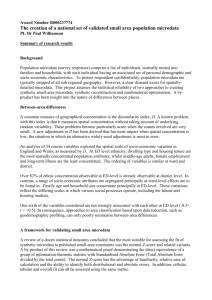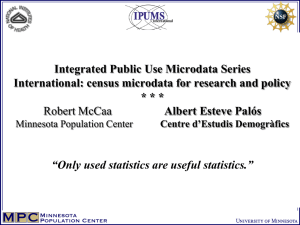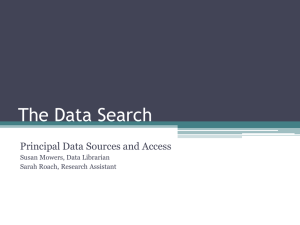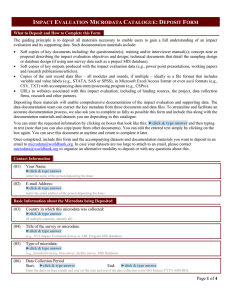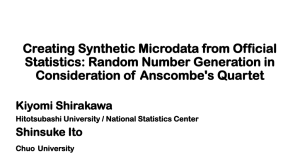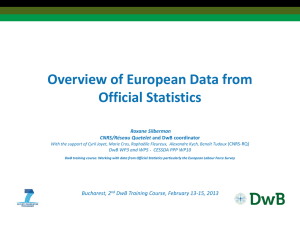The data landscape (continued)
advertisement
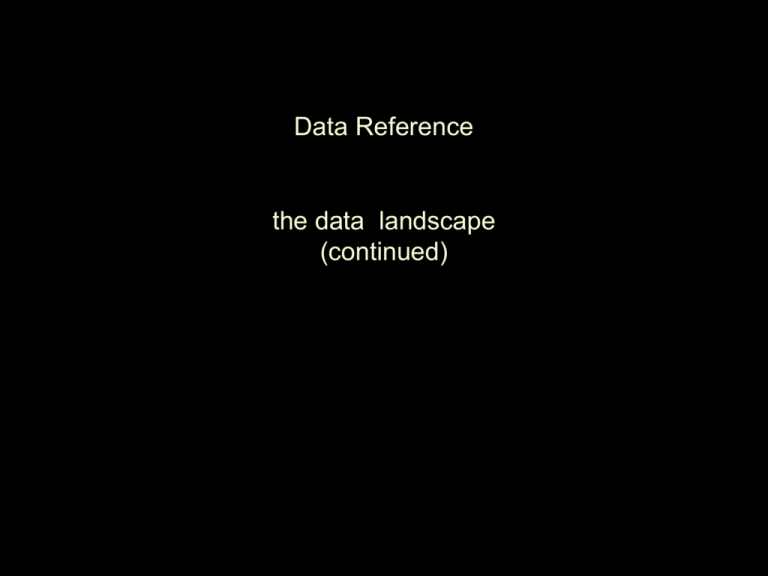
Data Reference the data landscape (continued) Surveys • Census • American community survey • Current population survey • General social survey • California poll • Roper organization • American National Election Survey Administrative records • • • • • • • • • Vital Statistics Health administration Crime reports Court reports Education reports SEC,FCC, FTC, etc. Legislative bodies Voting records Official economic statistics Data Statistics Data AGGREGATE DATA Statistics http://www.bls.gov/webapps/legacy/cpsatab7.htm 8.1 7.9 8.5 Rate of unemployment 20-24 yr-old Aggregated from data on individuals Data over time http://www.bls.gov/webapps/legacy/cpsatab7.htm Reformatted for use by statistical software Rate of unemployment 20-24 yr-old Aggregated from data on individuals Data over time Typical Characteristics of Aggregate Data Contrast with microdata (lowest level of observation, e.g., person, firm, event) Summarize microdata over time or space. Allow comparisons between geographic areas or across time File formatted for easy use by statistical software. Some Typical Aggregate Data Census data ("summary files") Economic data (time series) Business data (company or industry aggregates) The real world Data (microdata) Aggregate Data Statistical tables Scholarly literature Popular press Continuum of access Microdata – – Public use microdata Confidential microdata Aggregate data Databases eTables (digital, tabular, on the web or on CD, etc.) ePublications (on the web or CD. Reports, statistical abstracts, etc.) Scholarly publications Popular press Continuum of access Confidential microdata Public use microdata Aggregate data databases Scholarly literature popular press eTables ePublications Continuum of access Confidential microdata Public use microdata data Aggregate data databases Scholarly literature popular press (CONTENT) eTables ePublications statistics Continuum of access Confidential microdata Public use microdata Aggregate data databases Scholarly literature popular press eTables ePublications data (CONTENT) statistics less (INDEXING) more Continuum of access Confidential microdata Public use microdata Aggregate data databases Scholarly literature popular press eTables ePublications data (CONTENT) statistics less (INDEXING) more expensive (COSTS) free Continuum of access Confidential microdata Public use microdata Aggregate data Scholarly literature databases popular press eTables ePublications data (CONTENT) statistics less (INDEXING) more expensive (COSTS) free restricted (ACCESS) open Access Points •News.google.com •Lexis/Nexis •Newsbank •Factiva •Proquest •Etc… Popular Press Access Points •Scholar.google.com •Discipline indexes (Population Index, EconLit, PAIS, Sociofile, etc.) •Collection indexes (Muse, World Development Sources, Criminology, etc.) Scholarly Literature Access Points •Statistical Universe •Statistical compendia and abstracts •Bibliographies of statistical publications Statistics Access Points Aggregate data Aggregate data distributors •Fedstats: fedstats.gov •American Factfinder: factfinder.census.gov •International Financial Statistics: imfstatistics.org •Rand California: ca.rand.org •United Nations Common Database: unstats.un.org/unsd/cdb •Bureau of Labor Statistics: stats.bls.gov Access Points Microdata Data Archives and Data Libraries •ICPSR: www.icpsr.umich.edu •UK Data Archive: www.data-archive.ac.uk •Council of European Social Science Data Archives: www.nsd.uib.no/Cessda •History Data Service: hds.essex.ac.uk •American National Election Studies: www.umich.edu/~nes •Association of Religion Data Archives: thearda.com •NARA: www.archives.gov/research/electronic-records •More: odwin.ucsd.edu/idata Tip: use the tools you know to find statistics that will lead you to data Bibliographic indexes (OPACs for books and data, journal indexes, news indexes, statistical indexes) Web search engines "Agency" approach (who might have collected the data?) Known compilations of statistics Known data sources, archives, libraries Tip: work "backwards" from statistics to the data source Footnotes Bibliography Captions under tables and graphs text http://www.census.gov/prod/www/abs/popula.html#pop Tip: there is no one-and-only right way to begin a search for data Ask 3 data librarians where to start a datasearch and you'll probably get 3 different answers. Each reference provider brings his or her own skills and experiences, knowledge and strategies. Corollary: There may be many right end points of a search. Question One "I'm looking for data about trends in teenage smoking." Question Two "Have there been more deaths due to hot weather recently?" What have we learned Data come from surveys and administrative records Statistics come from data Aggregate data are summaries of microdata formatted for use by statistical software The "continuum of data access" provides many entry points for searching for data. The "best" search starts with tools that are familiar and may lead to statistics first. In 5 minutes or less we can get users focused and started on their exploration for data. Data Reference Next time: The data reference interview And… Cool tools and strategies




